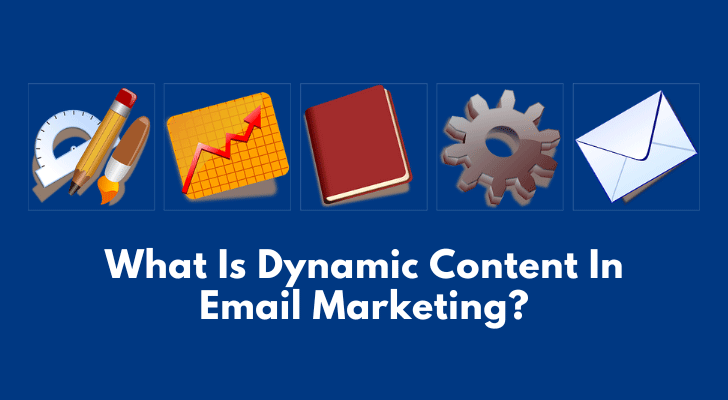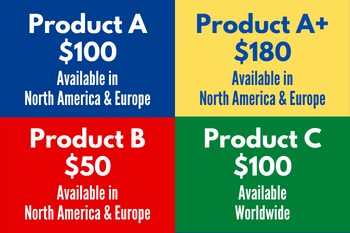We try to focus on creating a strong emotional connection with our audience. Crafting stories that resonate with them on a personal level, or using humour and unexpected elements in our content to surprise and delight them, etc. Whatever approach we take, the goal should be to create an experience that our audience will remember and appreciate. But we all have multiple types of audiences. What can we really do to make sure our messages are truly unique to each one of them?
That’s where dynamic content comes into force. That means that different people who receive the same email will see different content. This can be used to great effect in email marketing, as it allows you to tailor your message to specific groups of people.
For example, showing different products to different people, or offering different discounts to different groups. You can increase engagement and conversions by using this strategy. I hope this article will help you understand what dynamic content is, how it can be used in email marketing and some best practices for using it wisely.
What Is Dynamic Content?
Dynamic content is a type of content that can be changed or customized based on certain conditions or interactions. It can be used to customize a user's experience with your website, email, or application. It will help you increase engagement and conversions by delivering targeted content to users at the right time. Static content, on the other hand, is where all the users see the same message.
Dynamic content can be used in a number of ways, such as changing the copy or images on a landing page based on the user's location, providing different offers to users who have previously shown interest in similar products or showing related products to what the user is currently viewing.
How Can Dynamic Content Be Used in Email Marketing?
Most email marketing services have a dynamic content feature that allows you to show different content to different segments of your audience based on their interests or behaviors. Dynamic content can be used in email marketing in a number of ways. It can be used to;
- Customize the message for each individual recipient, making it more relevant and likely to drive engagement.
- Create a more interactive email experience, allowing recipients to take action directly from the email itself.
- Track engagement and understand which messages are resonating with your audience.
It’s beneficial in many ways including;
- Increased relevance and engagement.
- Improved open rates and click-through rates.
- More targeted and personalized messages.
- The ability to test and improve your campaigns over time.
- Greater ROI from your email marketing efforts.
How Dynamic Content Is Programmed
Dynamic content can be created through;
- Server-side includes (SSIs). SSIs are snippets of code that are inserted into web pages before they are served to the user. These snippets of code can be used to insert dynamic content into a page.
- Client-side scripting languages like JavaScript. With these languages, you can create scripts that will change the content of a page based on certain criteria. For example, you could create a script that changes the text color of a page depending on the time of day.
How To Create Dynamic Content For Email Marketing
Using email marketing software, you don’t have to create dynamic content from scratch. In fact, you don’t need any tech knowledge because there is a tool within the software that allows you to customize your email content for each individual subscriber.
Here are a few key steps that you need to follow in order to create effective dynamic content.
1. Segment Your List
Segmenting your list into different groups will allow you to send more targeted emails and ensure that each subscriber receives relevant content.
Use your email marketing software’s segmentation tool to target your emails based on demographic information (location, age, gender, etc.) or interests (what they've subscribed to, what they've clicked on in the past, etc.). This ensures that your recipients are seeing content that is most relevant to them.
2. Create Relevant Content
Once you have segmented your list, it's time to start creating relevant content. This content should be tailored to the specific needs of each group that you have defined.
For example, if you are targeting parents, you might want to include information about parenting tips or deals on baby products. If you are targeting young adults, on the other hand, you might want to include information about lifestyle choices or travel deals. By creating relevant content, you can increase the likelihood that your subscribers will engage with your emails.
3. Test, Measure, and Adjust
Send out a few different versions of your email to different groups of people and see which ones perform the best. Customize the message and call to action for each group of recipients.
Then, make changes to your content and see how it affects your results. Over time, you will be able to fine-tune your strategy and create dynamic content that is highly effective.
Examples:
Here are some examples of dynamic content you can use in your email marketing:
Personalized Subject Lines:
Subject lines that contain the recipient's name or other personalized information are more likely to get opened.
Time-Sensitive Content:
Offers that expire soon, or content that's only relevant for a limited time, can be included in your email to create a sense of urgency and encourage recipients to act quickly.
Geo-Targeted Content:
If you know where your recipients are located, you can target them with specific offers or content that's relevant to their location. For example, someone in New York might see an offer for a local event, while someone in California might see an offer for a different event.
Behavioral Targeting:
You can use data from previous interactions with your recipients to show them content that's more likely to be of interest to them. For example, if someone has clicked on links about travel in the past, you could show them ads for travel deals in your emails.
Pros and Cons of Using Dynamic Content
Pros:
Cons:
Tips for Using Dynamic Content
- It should be used sparingly and only when necessary, as it can be disruptive to the user experience if overused.
- Make sure that the content is relevant to the user and contextually appropriate.
- Avoid using too much dynamic content on a single email, as this can cause the page to load slowly or appear cluttered.
- Use tracking tools to monitor the performance, so that you can optimize and improve its effectiveness over time.
Alternatives to Dynamic Content
As we've seen, dynamic content is a powerful tool that can be used to personalize your website and improve the user experience. However, it's not the only way to personalize your site or improve the user experience. There are other options available, such as:
- A/B testing: A/B testing allows you to test two (or more) different versions of a page or piece of content to see which performs better. This is a great way to optimize your site for conversion without using dynamic content.
- Personalization through analytics: You can use data from your analytics platform to personalize your site for individual users. This could involve showing them different versions of emails based on their behavior on your previous emails or tailoring the messaging on your site to their needs and interests.
If you're not ready to use dynamic content yet, or if you want to supplement it with other personalization techniques, there are plenty of other options available to you.
Is Dynamic Content Applicable To Affiliate Marketing?
Dynamic content not only applies to e-commerce owners but applies to any type of business model, including affiliate marketing, or even educational organization or non-profit organization.
Whatever niche you promote, every user is on a different budget and is looking for different solutions, styles of products, and preferences.
Dynamic content allows you to send these emails automatically, so it will save time and effort to monitor your email performance each time.
How Can You Make Money Using Dynamic Content?
The aim of email marketing is to drive traffic to a webpage and ultimately, to increase sales. The webpage can be
- Your own sales page.
- Your affiliate product page.
- Blog post where your/your affiliate product is shown.
- A squeeze page to invite users to sign up with another offer.
You can include a link to your page in your email newsletter, and encourage people to click through to read more or check your recommended product. This can help you increase your website traffic and generate more leads and sales.
But if you use static content, you may lose some chances to make money.
For example, if you recommend Product A to all your subscribers, which is priced at $100;
- Some of them feel it’s too expensive, and they may think all your products are at unaffordable prices for them, so they may unsubscribe.
- The product may not be available in some of your subscribers’ countries. When they click the link in your email, they’ll be directed to a blank page.
When dynamic content is used in your email, you can recommend Product B instead which is inexpensive, or Product C instead which is available to purchase worldwide, respectively.
Another example is that you can segment the subscribers who have purchased Product A further, and promote Product A+, which provides extended solutions. So you can make extra money from it.
Conclusion
People always talk about email marketing to raise revenue, but without building relationships with your subscribers, it cannot be achieved. And to build good relationships, you must regularly send quality content and helpful information. The problem is, one piece of helpful information for some can be a useless piece of information for others. To create an exclusive offer that applies to most of your subscribers, dynamic content becomes crucial.
While dynamic content may require a bit more effort to set up, the results are worth it when you consider the potential increase in ROI.
By allowing users to control the content they see on your site, you can keep them coming back for more. Plus, with so many different ways to use dynamic content, there's sure to be an option that fits your needs. So why not give it a try?
What Do You Advocate?





Thank you for your article, it’s very intriguing for me. Overall, email marketing is a good idea, I think. But with not so much mnoey it’s very hard to manage expectations if I use dynamic content. It won’t guarantee success in affiliate marketing, but maybe I really need to learn solid foundation.
Thanks for your comment, Sam. If you need a hand don’t hesitate to ask. Good luck!